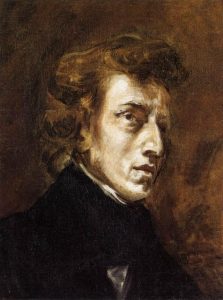6. Music of Fryderyk Chopin (1810–1849)
Fryderyk Chopin (1810–1849), son of a French father and Polish mother, grew up in and around Warsaw, Poland. His family was a member of the educated middle class; consequently, Chopin had contact with academics and wealthier members of the gentry and middle class. He learned as much as he could from the composition instructors in Warsaw—including the keyboard music of Bach, Mozart, and Beethoven—before deciding to head off on a European tour in 1830. The first leg of the tour was Vienna, where Chopin expected to give concerts and then head further west. About a week after his arrival, however, Poland saw political turmoil in the Warsaw uprising, which eventually led to Russian occupation of his home country. After great efforts, Chopin secured a passport and, in the summer of 1831, traveled to Paris, which would become his adopted home. Paris was full of Polish émigrés, who were well received within musical circles. After giving a few public concerts, Chopin was able to focus his attention on the salons—smaller, semi-private events, similar to soirées, generally hosted by aristocratic women for artistic edification. There and as a teacher, he was in great demand and could charge heavy fees.

Much like Robert and Clara Schumann, Chopin’s first compositions were designed to impress his audiences with his virtuoso playing. As he grew older and more established, his music became more subtle. Also, like the Schumanns, he composed pieces appropriate in difficulty for the musical amateurs as well as works for virtuosos such as himself. Unlike many of the other composers we have discussed, Chopin wrote piano music almost exclusively. He was best known for character pieces, such as mazurkas, waltzes, nocturnes, etudes, ballades, polonaises, and preludes.
Focus Composition: Mazurka in B-flat Major, Op. 7, No. 1
Chopin’s Mazurka in B-flat Major, Op. 7, No. 1 was published in Leipzig in 1832 and then in Paris and London in 1833. The mazurka is a Polish dance, marked by its triple meter in which beat two rather than beat one gets the stress. Mazurkas were rather popular in Western Europe as exotic stylized dances. They are typically composed in strains and are homophonic in texture. Chopin sometimes incorporated folk-like sounds in his mazurkas, such as drones and augmented seconds. A drone is a sustained pitch or pitches. The augmented second is an interval that was commonly used in Eastern European folk music but very rarely in the tonal music of Western European composers.
All of these characteristics can be heard in this mazurka, together with the employment of rubato. Chopin was the first composer to widely request that pianists use rubato when playing his music.
Listening Guide
Artur Rubinstein, piano
Composer: Fryderyk Chopin (1810–1849)
Composition: Mazurka in B-flat Major, Op. 7, No. 1
Date: 1832
Genre: character piece for solo piano
Form: a a || b a b a || c a c a||
Nature of Title: mazurka, indicating a stylized dance based on the Polish dance mazurka
Performing Forces: solo piano
What we want you to remember about this composition:
- This mazurka is in triple time with emphasis on beat two.
- The texture is homophonic.
- Chopin asks the performer to use rubato.
Other things to listen for:
- Its form is made of three strains: a, b, and c.
- The “c” strain uses a drone and interval augmented seconds.
| Timing | Performing Forces, Melody, and Texture | Form |
| 0:00 | Triple-meter theme ascending up the scale and then descending, with brief ornaments on beat two of the measure; B-flat major, in homophonic texture with left-hand boom-chuck-chuck accompaniment pattern (single bass note followed by two blocked chords); repeated | a a |
| 0:33 | A contrasting theme that oscillates, lighter in character. First theme returns. |
b a |
| 1:01 | Repetition (marked with repeat sign on the music) | b a |
| 1:29 | Folk-like melody using augmented seconds, played very quietly, with the drone in the left hand; minor sounding; rubato First theme returns. |
c a |
| 2:00 | Repetition (marked with repeat sign on the music) | c a |
The momentary speeding up or slowing down of the tempo within a melody line, literally “robbing” time from one note to give to another.
